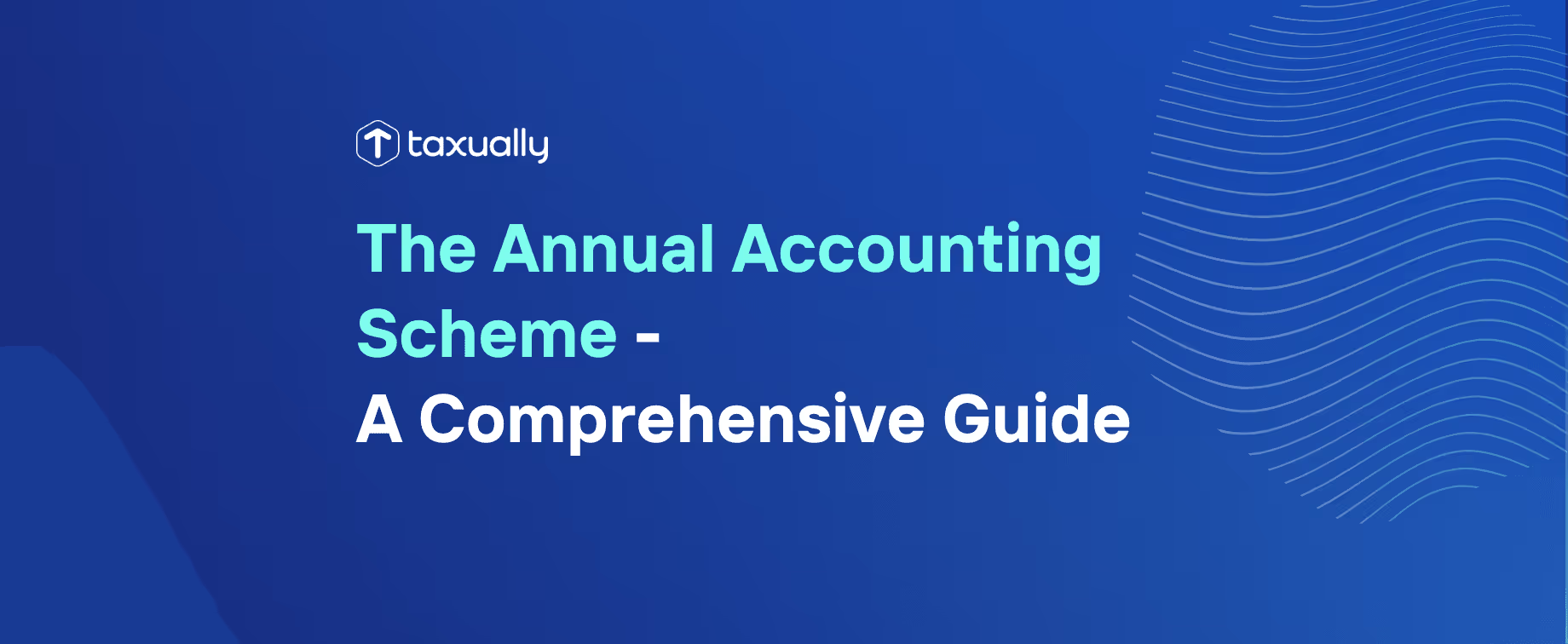Key takeaways
- The VAT Annual Accounting Scheme simplifies the VAT return and payment process for eligible businesses.
- Eligibility criteria include a taxable turnover not exceeding £1.35 million, a valid registration number, and meeting certain exceptions.
- The advantages of this scheme are streamlined administration, reduced workload & flexible payments. Drawbacks must be taken into account before enrolling in it.
If you're looking to simplify your UK business's VAT return and payment process and better manage your cash flow, the VAT Annual Accounting Scheme could be the solution. In this guide, we'll explore the ins and outs of this scheme, its eligibility criteria, enrolment process, payment options, and expert tips to maximise its benefits.
Understanding the VAT Annual Accounting Scheme
The VAT Annual Accounting Scheme is a system designed to ease the burden of VAT returns and payments for eligible businesses. Instead of submitting a VAT return four times a year and making quarterly payments, as required under the Standard VAT Accounting Scheme, the Annual Accounting Scheme enables businesses to submit one VAT return yearly and make instalments towards their final VAT bill.
These advance VAT payments can be made in either monthly or quarterly instalments, providing flexibility for businesses to manage their cash flow more effectively during the annual accounting period.
To be eligible for the Annual Accounting VAT Scheme, businesses must have an estimated VAT taxable turnover not exceeding £1.35 million and be up to date with their VAT returns and payments. Businesses must keep digital VAT records as mandated by the government. They also need to use software to submit their respective VAT returns.
The scheme is particularly suitable for businesses with stable or predictable turnover, but it may not be the best fit for those that regularly reclaim VAT or experience significant fluctuations in turnover.
Eligibility criteria for the Annual Accounting Scheme

Understanding the eligibility criteria for the VAT Annual Accounting Scheme is crucial in determining whether this scheme is the right fit for your business. To be eligible, businesses must have an estimated taxable turnover not exceeding £1.35 million and be registered for Value Added Tax with a valid VAT registration number.
It's important to note that businesses that are not current with their VAT returns or payments, and those that anticipate reclaiming VAT regularly, are not eligible to use the scheme.
There are certain exceptions that may render a business ineligible to join the VAT Annual Accounting Scheme. A business is ineligible to join the scheme if they have departed the scheme within the preceding twelve months, are not current with their VAT payments or VAT returns, or if they are insolvent.
Assessing your business’s eligibility and understanding these exceptions are essential steps in determining if the Annual Accounting Scheme is the right choice for you.
Enrolling in the VAT Annual Accounting Scheme
Once you've determined your eligibility for the VAT Annual Accounting Scheme, the next step is to enroll. You can join the scheme online through your HMRC account or by submitting a postal application using the VAT600AA form.
In the following sections, we'll delve into the step-by-step process for both online and postal applications, ensuring a smooth enrollment experience.
Online application
To apply for the VAT Annual Accounting Scheme online, simply log in to your HMRC account and access the VAT600AA form on the HM Revenue & Customs website. Fill out the required information, such as your business name, address, and VAT registration number. Once completed, select the ‘Submit’ button at the bottom of the page to submit your application.
After submission, HMRC will review your application and be in touch with you regarding the outcome.
Postal application
If you prefer to apply for the VAT Annual Accounting Scheme by post, you'll need to print and complete the HMRC form VAT600AA and submit it to HM Revenue & Customs. Make sure to fill out all the necessary information on the form and send it to the appropriate address.
After submitting the form, wait for a response from HM Revenue & Customs regarding the progress of your application.
Navigating VAT payments under the Annual Accounting Scheme
Now that you're enrolled in the VAT Annual Accounting Scheme, it's time to familiarise yourself with the different VAT payment options available. Under the scheme, you can make advance VAT payments in either monthly or quarterly instalments, providing flexibility to manage cash flow during the annual accounting period.
The final payment, known as a ‘balancing payment’, is the difference between your advance payments and the actual VAT bill determined on your VAT return, which is due two months after the end of the accounting period.
Let’s explore each of these payment options in more detail in the following subsections.
Monthly payments
Under the VAT Annual Accounting Scheme, you have the option to make nine monthly instalments towards your VAT liability during the vat accounting period, determined by your projected VAT bill for the year. These monthly payments help spread out your VAT liability over the course of the year, easing the pressure on cash flow management.
To calculate the amount of each monthly payment, you can use the HMRC VAT calculator to estimate your expected VAT bill. Payments can be made via the HMRC website or by mail.
Quarterly instalments
If you prefer to make payments less frequently, you can opt for quarterly instalments under the Annual Accounting Scheme. This involves paying 25% of your estimated VAT bill each quarter, enabling you to manage your cash flow more effectively with fewer payment deadlines.
However, it's important to keep in mind that if your actual VAT bill exceeds your estimated VAT bill, you may be required to pay additional instalments to cover the difference. This option is particularly beneficial for businesses with a more predictable turnover throughout the year.
In the event of an overpayment, businesses can apply for a refund, providing peace of mind and financial security.
Managing your annual VAT return

Efficient management of your annual VAT return is essential for businesses enrolled in the VAT Annual Accounting Scheme. This involves maintaining complete and up-to-date records of all suppliers and purchases, ensuring that you have accurate information when it comes time to submit your VAT return.
Additionally, you must include input invoices in the VAT return for the corresponding tax period. By staying organised and diligent in your record-keeping, you can streamline the process of submitting your annual VAT return and ensure compliance with HMRC regulations.
Submitting your annual VAT return under the Annual Accounting Scheme also requires that you do so electronically through the specified portal. This ensures timely and accurate submission of your return, minimising the risk of errors or penalties.
By adopting best practices for managing your annual VAT return, you can reap the full benefits of the Annual Accounting Scheme and maintain a strong financial footing for your business.
Weighing the pros and cons of the Annual Accounting Scheme
Before fully committing to the VAT Annual Accounting Scheme, weighing the pros and cons is essential to determine if this is the best option for your business.
In the following subsections, we'll look at the advantages and disadvantages of the scheme, providing a balanced analysis to help you make an informed decision.
Advantages
The VAT Annual Accounting Scheme offers a variety of advantages for eligible businesses. By streamlining administration and reducing the workload associated with submitting quarterly VAT returns, the scheme allows businesses to focus on other important aspects of their operations.
Also, the flexibility of making either monthly or quarterly advance VAT payments enables businesses to manage their cash flow more effectively, minimizing financial stress and promoting growth. Ultimately, the Annual Accounting Scheme can lead to improved efficiency and financial stability for eligible businesses.
Disadvantages
Despite its numerous advantages, the VAT Annual Accounting Scheme may not be suitable for all businesses. One potential drawback is the requirement to keep track of future taxable supplies, which can be time-consuming and challenging for some businesses. Also, interim payments under the scheme may exceed the necessary amount based on prior years’ performance, which can negatively impact cash flow.
Businesses that regularly reclaim VAT may find the scheme unsuitable, as they are restricted to claiming refunds on an annual basis. It's crucial to consider these disadvantages and assess whether the scheme aligns with your business’s unique needs and goals.
Exiting the VAT Annual Accounting Scheme
If you decide that the VAT Annual Accounting Scheme is no longer suitable for your business, whether due to ineligibility or personal preference, you can exit the scheme by notifying HMRC. You must write to HMRC to leave as soon as possible. They will provide confirmation regarding this.
It's important to be aware of the implications of exiting the scheme, as you will need to transition back to standard VAT accounting and comply with the requirements associated with that method.
Upon exiting the Annual Accounting Scheme, you must account for your VAT in the customary manner, which necessitates submitting a VAT return every three months and paying any VAT due. This transition may require adjusting your financial management practices and record-keeping to ensure compliance with standard VAT accounting requirements.
Maximising the benefits of the Annual Accounting Scheme
To fully maximise the benefits of the VAT Annual Accounting Scheme, it's vital businesses implement best practices. For example, diligently managing cash flow by making regular payments to HMRC throughout the year can help prevent financial strain and promote steady growth. Also, maintaining awareness of any fluctuations in turnover and changes in the UK VAT rate can help ensure that the appropriate payments are being made.
To make the most of the Annual Accounting Scheme, businesses must ensure they remain compliant with regulations and statutes associated with the scheme, as well as be mindful of potential tax implications. By staying up to date with the latest information and best practices, you can fully harness the advantages of the VAT Annual Accounting Scheme and elevate your business’s financial management to new heights.
Conclusion
The VAT Annual Accounting Scheme offers many benefits for eligible businesses, including simplified administration, improved cash flow management, and enhanced tax planning. Once you understand the eligibility criteria, enrollment process, and payment options, you'll find submitting VAT returns and making payments easier than ever before, and you'll improve your business’s financial management in the process.
Do you need help with your VAT compliance? Book a free call with one of our VAT experts to find bespoke solutions for your business, optimize your VAT costs, and reach millions of new potential customers.
Frequently asked questions
New Year's Day - 1/1/2024Memorial Day - 5/27/20244th of July - 7/4/2024Labor Day - 9/2/2024Thanksgiving Day - 11/28/2024Day after Thanksgiving - 11/29/2024Christmas Eve - 12/24/2024Christmas Day - 12/25/2024
What is the annual accounting scheme for VAT returns?
The Annual Accounting Scheme is a method of paying VAT that enables businesses to make regular payments towards their annual VAT bill and submit one VAT return each year.
Small businesses can benefit by being able to pay their VAT more flexibly, rather than having to file four separate returns annually.
Who is eligible for the VAT annual accounting scheme?
If you’re a VAT registered business with an estimated taxable turnover of less than £1.35 million in the upcoming 12 months, you're eligible to join the VAT Annual Accounting Scheme.
How do I leave an annual accounting scheme?
To leave the Annual Accounting Scheme, you must write to HMRC and provide notice. Your eligibility in the scheme will determine when you can leave, and after leaving, you must wait 12 months before re-entering.
Additionally, if your annual taxable turnover exceeds £1.6 million, you must leave the scheme.
Can you do VAT returns annually?
Yes, you can do VAT returns annually through the Annual Accounting VAT Scheme.
What are the payment options under the VAT Annual Accounting Scheme?
The VAT Annual Accounting Scheme offers payment options of monthly or quarterly instalments for advance VAT payments.



















